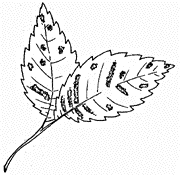All elm species have been known to suffer damage from the elm leaf beetle. In Texas this pest can be found wherever elms grow. Shade and ornamental elms that are repeatedly defoliated may die or be weakened to the extent that they are susceptible to other insect and disease problems. Adult beetles eat holes in the leaves, but the larvae cause most of the damage due to heavy skeletonization of the leaf surface. Elm leaf beetles overwinter as adults near the host tree in protected places - commonly in and around buildings. If large populations develop in residential areas, the beetles may become a nuisance as winter approaches and they begin to move into houses to overwinter. Even during the winter, the adults will become active and crawl around on warm days. Beetles will begin to leave their protected overwintering sites in the spring to fly to nearby elm trees about the time elm leaf buds begin to swell. Adults feed by chewing holes in the unfolding leaves. Egg laying begins a short time later.

Masses of up to 25 yellow-orange eggs are deposited on the underside of the leaves. The eggs will begin to hatch in about one week.
When the eggs hatch, small, black, grub-like larvae begin to feed on the undersurface of the leaf. As the larvae mature, they become green to dull yellow and have two black stripes along the dorsum; the head, legs and tubercles are black, and there is a broad dull yellow stripe down the middle of the back. They are about 1/2 inch (12 mm) long. The larvae feed for 2-3 weeks on the undersurface of the leaves leaving only the veins and upper leaf surface. The leaves soon dry out and turn brown and may drop from the tree.
When leaf drop is abundant, the tree often produces a new flush of growth which is usually consumed by other elm beetles. When conditions are severe and trees are without leaves for several consecutive years, limbs or the entire tree may die. When the larvae are full grown they crawl to the lower portion of the tree and pupate. The yellow pupae may be fully exposed on the ground and tree trunk, or protected in bark crevices and other hiding places.
Transformation to the adult stage requires 1-2 weeks. At this time the new adults return to the foliage of the same or adjacent elms and lay eggs to continue the life cycle. The adults that emerge in the fall will seek sheltered places to overwinter. In Texas, 2-4 generations per year may occur.
Adult beetles are about 1/4 inch (6 mm) long, yellowish to dull green in color with a black strip along the edges and a black spot at the base of the wing covers.
Control of the elm leaf beetle can be achieved by using one of the following insecticides: Di-Syston 15 percent granular systemic insecticide, Sevin 4 flowable, Sevin 50-W, Sevimol 4, or Methoxychlor 22 percent EC. All suggested chemicals must be currently registered and labeled for use by the U. S. Environmental Protection Agency and the Texas Department of Agriculture.
Before using any pesticide, read and carefully follow all application directions, cautionary statements and other information appearing on the label.